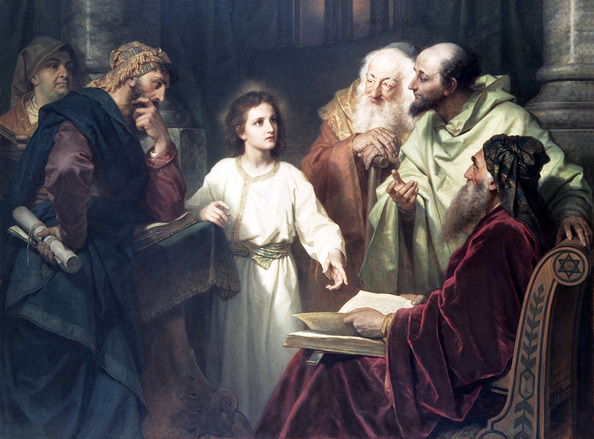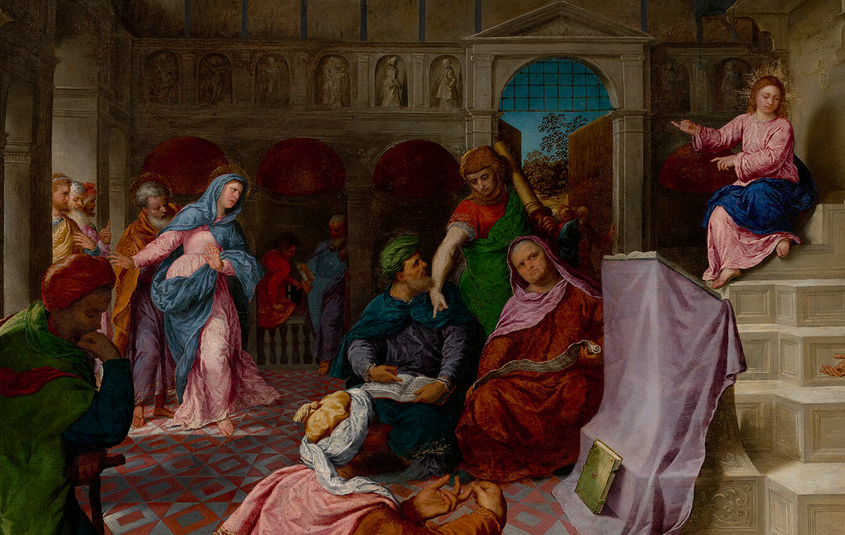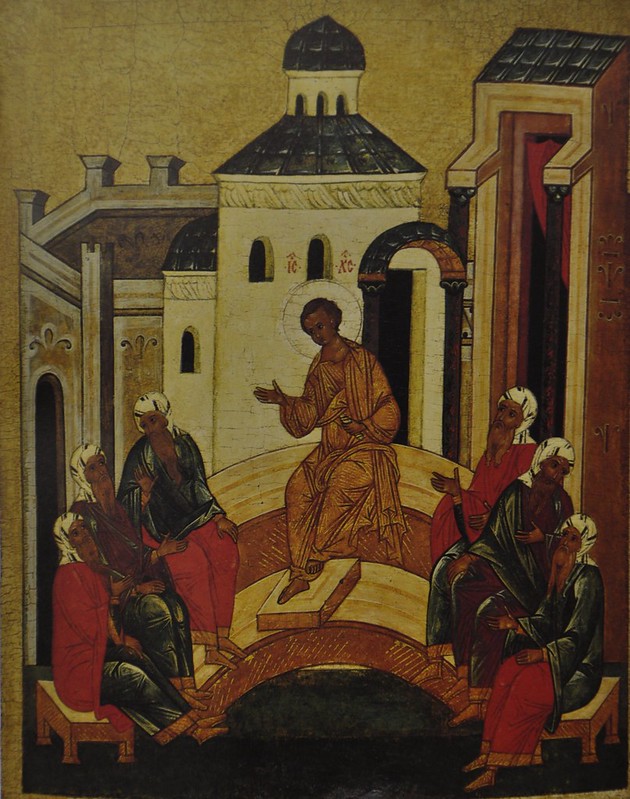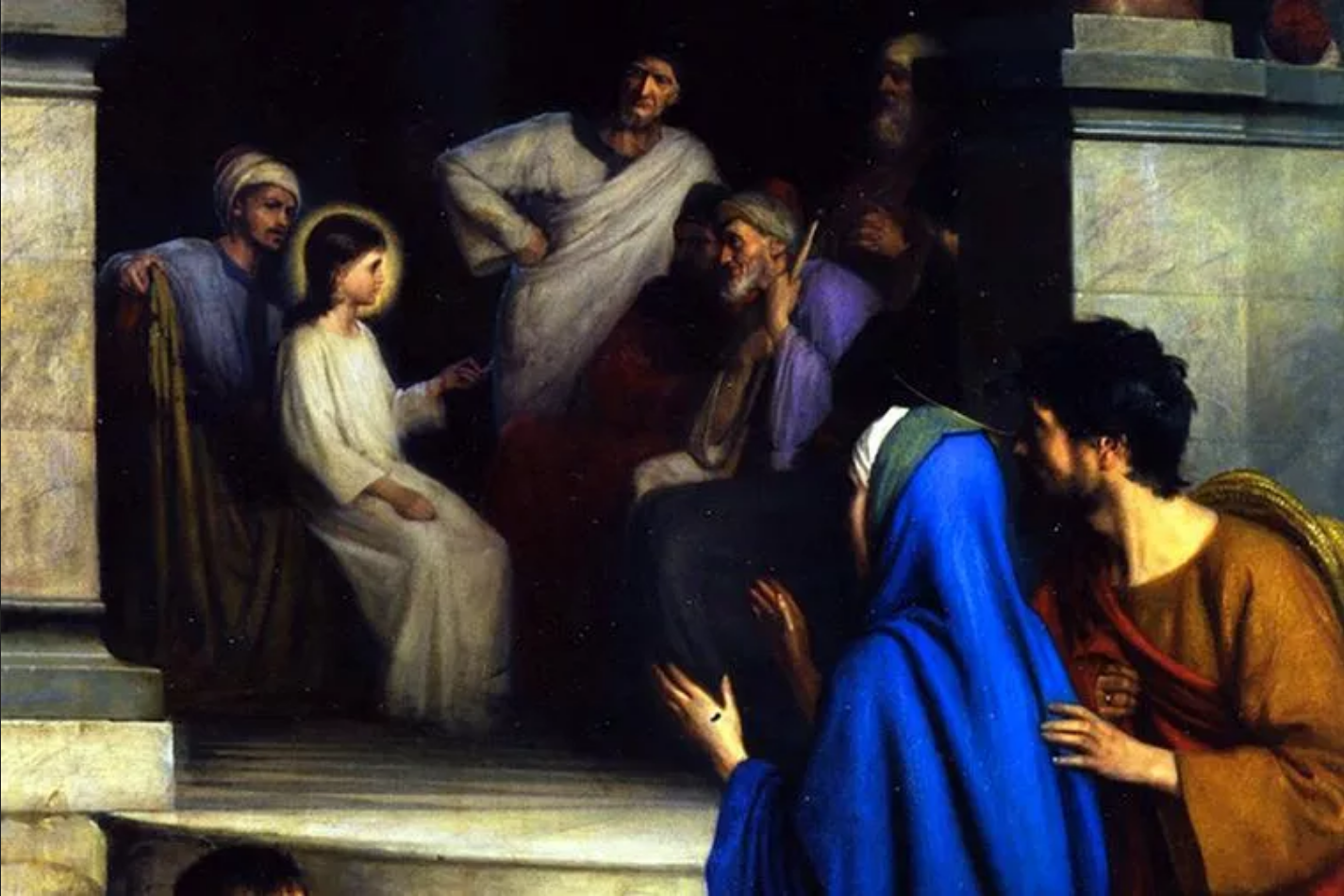Finding of the Child Jesus in the Temple
☩
PAX
Homily
19 January 2025
Finding of the Child Jesus in the Temple/2nd Sunday after Epiphany
Ecce pater tuus et ego dolentes quaerebamus te.
‘Behold Thy father and I have sought Thee sorrowing.’
A Mectildean feast
If you think that this gospel sounds familiar, you’re right, because we heard it last Sunday! We could have heard it two times last Sunday, because it was the Gospel of the First Sunday after the Epiphany and also the Gospel of the Feast of the Holy Family which is celebrated on that same day. Each of those Masses has its own distinct flavour, its own distinct light that it sheds upon the mystery contained in this Gospel. The Mass of the Holy Family focuses on how this Gospel shows Our Lord as a member of a human family, the model for all Christian families, while the more ancient Mass of the First Sunday after the Epiphany contemplates that gospel in a slightly different light, as an Epiphany of Our Lord. But today we hear that Gospel in the context of this feast which is not widely celebrated, a feast which we find in the traditional calendar of the Benedictines of Perpetual Adoration, where this day is celebrated as the Feast of the Finding of the Child Jesus in the Temple. Today we contemplate this Gospel scene once again, and today the texts of the Mass and the Office focus us on Our Lady’s seeking for Jesus, which is mentioned four times in the Gospel. The feast gives us Our Lady as the model of the seeking after the Face of Jesus which is the basic theme of this Mass: Tibi dixit cor meum, quaesivi vultum tuum. ‘To Thee hath my heart said, I have sought Thy Face.’ (Ps. 26, Introit)
Seeking the Face of God
Seeking the Face of God is the mission of every human life. Every human being has been created, called into being, in order to look upon the Face of God. This is what we are created for: the beatific vision, that is, the sight of God which will make us happy and blessed. This is not something that we are owed by nature; God could have created us without calling us to it. But we know, thanks to God’s revelation, that He has in fact chosen to call all the human beings whom He has created to this goal which is beyond what our nature is capable of by itself. And so each of us, every human being, has been made to look upon the Face of God. Yet we cannot look upon the Face of God in this life: Scripture says that no one can see God and live. For the Divine Essence is utterly beyond anything that our natural vision and our natural intelligence can contemplate. And yet this is what we are created for. And so, since this is vision of God is the goal of our creation but is not something that we can attain here in this life, we can only spend our life in this world constantly seeking after Him—a seeking which, while we are in this mortal life, never fully reaches its conclusion. And this is why this Mass urges us to seek the Face of the Lord constantly: Quaerite faciem ejus semper. (Ps. 104, Alleluia verse) If we think that we’ve arrived at our goal, then by definition we are deluded. As long as we are in this life, we have not yet arrived at that vision, and so we can never tell ourselves that we’ve arrived, because that would mean that we would stop seeking.
Among their relatives and acquaintances
It’s easy enough for us to be lured by the promises of the world into stopping short in our search, into thinking that here in this world we can find the thing that we’re seeking, something that will satisfy all the desires of our heart. But in fact nothing here can satisfy us; nothing can bring to its fruition that seeking which should characterise our entire life in this world. Thus we are told in the Gospel that Mary and Joseph sought for Our Lord first ‘among their relatives and acquaintances’, but they did not find Him there. This is a symbol of our seeking the Face of God in this world: we can try to seek Him ‘among our relatives and acquaintances’, that is, among the things and the people of this world which are familiar to us, with which we are at home. But we ultimately cannot find Him there because He is utterly beyond all that He has created: no matter how good it is, none of it comes close to being God, to providing us with that vision of God which alone can make us happy.
A vocation to seek God
This is the reason for the monastic vocation, which is a vocation to seek God constantly: that is the fundamental condition of the monastic vocation that Saint Benedict lays down for the postulant in Chapter 58 of the Holy Rule: si revera Deum quaerit, ‘if he truly be seeking God’. And since we will only ultimately find God by being united with Him through charity, through His love dwelling in us, our ’seeking constantly’ after the Face of God—which is what we’ve come to the monastery to do, and which is what every Christian is called to do—takes on the form of a constant schooling in the love of God. ‘Seeking God’ concretely means learning to love God, to love Him with all our heart and soul, and to prefer nothing to His love.
Seeking Him in sorrow
‘Thy father and I have sought Thee sorrowing’, Mary says, and our life of searching for God can certainly be full of sorrow. We can become discouraged because He seems deliberately to hide Himself. At times He may give us a little glimpse of Himself, only to hide Himself again quickly. St Ambrose described this in the second Nocturn at Matins this morning, commenting on the words of the Canticle of Canticles, from which we also heard from in the Epistle of today’s Mass. The bride describes searching for the bridegroom; he is knocking on the door and she opens to him, but suddenly he’s gone. St Ambrose says: ‘Do not think that you are displeasing to Him—you who have called, you who have prayed, who have opened—just because He goes away so quickly. He often allows us to be tested.’ (St Ambrose, Commentary on Luke, II) This is the experience of everyone who has sought God for any length of time: we often have to seek Him sorrowing. Our Lady experienced this, as we heard in today’s Gospel. Many of the great Saints of modern times experienced this in a very deep way: even if they were known outwardly for their great joyfulness which they spread to all those around them, inwardly they felt utterly desolate, sometimes for years and years. We can think of the last year of St Thérèse’s life, when it seemed to her that everything was an illusion, as if there was no Heaven, as if she had no faith at all. We can think of the Servant of God Sister Clare Crockett, whom all of her companions thought to be a very joyful person, but who inwardly suffered terrible desolation, the seeming absence of God. It can happen, of course, that the seeming absence of God in our lives is caused at least in part by our infidelities to His grace, by the fact that we have not repented of the things that are holding us back from union with Him: but even then the hiding that God does is for our good, in order to bring us back to Himself, in order to make us repent, to make us seek Him more earnestly. As long as we are in this life, all that we suffer is what God permits for our good, for the good of our souls, to bring us back to Him. But even if we have not been unfaithful, God may still hide Himself, as He hid Himself during these three days from His Mother. This is what St Ambrose tells us: that He often allows us to be tested in order to incite us to seek Him more earnestly, and thus, ‘even if He seems to have gone away, search once again.’ The Canticle goes on to say finally, ‘I found him and I will not let him go.’ The fact that we have to seek Our Lord in desolation and in darkness makes us appreciate all the more the little ways in which He allows us to find Him; it makes us desire to hold on to Him and not let Him go.
Finding Him in the heavenly Temple
Ultimately they do find Him: ‘They went back to Jerusalem seeking Him…after three days they found Him in the Temple.’ They don’t find Him among their friends and relations, that is, among the things of this world: they find Him only in the Temple after three days. These three days, as the Fathers tell us, are a symbol of the three days of Our Lord’s absence after His Crucifixion, when He was in the Tomb. Our Lord is not to be found here in this world: He is to be found only in the Temple—that is, in Heaven—after three days—after His Cross and His Burial. This is what we must pass through with Him before we are to find Him, as Our Lady too had to pass through those three dark days of His disappearance before finding Him in His glory, in the Resurrection. And so we should long to have this share in Our Lord’s Passion; we should long to share His Cross because we know that on the far side of the Cross we will find Him in His Heavenly Temple.
Seeking and finding Him in the Most Blessed Sacrament
But this share in Our Lord’s Passion and this finding of Him in the Temple after three days is something that we are already privileged to experience here in this life in mystery, in the Most Blessed Sacrament: it is here that we share mystically in His passion, which He reenacts sacramentally upon the Altar, and it is here that we find Him in the Temple, on the Altar which makes present for us the heavenly Temple where He reigns in glory. And thus we can appreciate why our venerable Mother Mectilde has such a great love for this feast, for this mystery, because it expresses our seeking of the Lord’s Face in the Eucharist. In the Most Blessed Sacrament we find that Face Which we are seeking: and yet we still continue to seek, because the veil remains. We know He is there, but we see Him only by faith, so we still have to continue seeking Him, longing for the full vision of His Face. This is what is expressed in the Postcommunion of today’s Mass, which asks that as we receive these holy Gifts, we might continue to seek Them as we receive, and in seeking receive Them without end: et percipiendo requirant, et quaerendo sine fine percipiant. We receive Our Lord already, we contemplate Him, we find Him in the Eucharist, and yet we have to continue to seek Him. But He does nonetheless already give us, here in this Sacrament, union with Him: we abide in Him and He in us, as long as we continue to abide in His love, to live in charity, in grace, in the friendship of God, loving Him with all of our heart. This is what this feast calls us to: to seek Our Lord constantly in this life, knowing that nothing in this world will satisfy the desire of our hearts until we can see His face, and to find Him here in the Sacrament of His love, looking forward to the full vision of His glory in the life to come.
Subject to Mary
But after this finding, after this encounter, He returns with them to Nazareth, ‘and He was subject to them.’ We considered this last week in the context of the Mass of the Holy Family, focused on Our Lord subject to Mary and Joseph as a member of a human family. But there is a further dimension to this subjection which we see in the Gospel of the Second Sunday after the Epiphany which is also celebrated today, the Gospel of the wedding feast at Cana. As we contemplate Our Lady in her search for her Son, we contemplate also Our Lord and His willing subjection to her, a subjection that St Ambrose says, in today’s third Nocturn homily, was not out of weakness but out of love and devotion. Our Lord, strictly speaking, didn’t need to be subject to Mary, but He chose to be out of love. Ambrose goes on to say that this is an image of His subjection to the Father within the Trinity. In the Trinity the Son is, in a certain sense, subordinate to the Father, although He is in no way less than the Father. He is no less divine than the Father is, but He nonetheless is perfectly subject to his Father, and they have in fact but One Divine Will. Our Lord chose in His human life to mirror this subjection to His Father by lovingly subjecting His true human Will to His Mother, even though in this case He was clearly greater than she. He chose to be dependent upon her: even after He grows to adulthood He chooses to be dependent upon her for His first miracle at the wedding feast at Cana. As He had been dependent upon her all through His life up to that point, so too He would be dependent on her to begin His public ministry, just as He would also have her with Him at His cross to offer with Him His sacrifice to the Father, and as He would have her, even after His Resurrection and Ascension, in the Cenacle as He sent the Holy Spirit upon the Church.
Imitating Our Lord in submission to Mary
Our Lord wants us to imitate Him in this loving submission to His Mother. This is the basis for our devotion to Our Lady, and the basis of the teaching of St Louis Marie de Montfort on consecration to Mary: that it is a perfect way of imitating Our Lord. He writes: ‘This Infinite Wisdom…found no more perfect or direct means of glorifying His Father and saving mankind than by submitting Himself in all things to the Blessed Virgin…During those long years Christ gave more glory to God His Father by His submission to and dependence on the Blessed Virgin than He would have done had He spent those years in working wonders, in preaching throughout the whole world, and in converting all. For so the Heavenly Father had ordained it…How greatly indeed therefore do we glorify God when, following the example of Jesus, we submit ourselves to Mary.’ He goes on to say that not only Our Lord His Humanity, but the Blessed Trinity Itself, chooses to depend upon Mary: ‘The Father did not give and does not give His Son except through her, and through her alone does He communicate His graces…Only through her has the Holy Ghost formed Jesus Christ, and only through her does He form the members of Christ’s Mystical Body, nor apart from her does He dispense His gifts and His favours. After these rich and awe-inspiring examples of the conduct of the Blessed Trinity, can we, without extreme blindness, dispense with Mary in our lives, refuse to consecrate ourselves to her and to depend on her as our way leading to God and to the sacrificing of ourselves to God’s honour and glory?’
Learning to seek Jesus with Mary
We ask then, as we move forward in this last part of Christmastide, for the grace to do so in constant union with and submission to the Mother of God: that she may teach us to seek, with her, Him Who is the reason for which we’ve been created, the only One Who will satisfy all the desires of our soul. May she teach us to seek Him with her; to find Him, crucified and risen, after the sorrows of this life, in His heavenly Temple, of which we receive a foretaste here as we find Him under the sacramental veil. So, seeking Him, may we receive Him and find Him, and as we receive Him, may we continue to seek Him without end, until faith gives way to the full vision of His glory.
